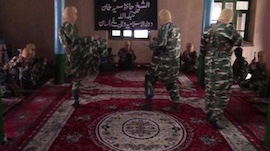Charting Strategies: Analyzing Taliban and Regional Resolve in Combating ISIS-K

Charting Strategies: Analyzing Taliban and Regional Resolve in Combating ISIS-K
Mahmut Cengiz
ISIS-Khorasan (ISIS-K) is an affiliate of the Islamic State of Iran and Syria (ISIS) that has gained attention following recent attacks in Iran on 4 January 2024, and in Russia on 22 March 2024. However, doubts persist about the effectiveness of countries in countering ISIS-K.

ISIS-K Propaganda Footage Filmed inside a Darzab Mosque. Source: Captured by Afghan and US Special Operations Forces; Defense Visual Distribution Service (DVIDS), 21 March 2018, Public Domain.
Background
ISIS, also known as the Islamic State of Iraq and Syria, rose to prominence as a terrorist organization by controlling territory in Iraq and Syria, where it operated as a de facto government; governing over six million people between 2015 and 2016. Infamous for its violent tactics, ISIS caused numerous casualties, resulting in over 33,000 deaths in Iraq and Syria alone between 2012 and 2015. Since 2018, the group has been responsible for more than 1,000 terrorist attacks annually. The group’s influence extended beyond the Middle East, inspiring individuals in Western countries to carry out acts of terrorism and targeting civilians. With a sophisticated online presence, ISIS effectively utilized cyberspace and social media to recruit followers. Additionally, ISIS served as a model for other terrorist groups, who adopted its ideology and violent methods. ISIS also boasted a network of regional affiliates, with ISIS-K receiving particular attention for its deadly attacks and expanding influence in Afghanistan and neighboring countries like Uzbekistan and Tajikistan. Recent attacks attributed to ISIS-K in Russia and Iran have further highlighted its global reach and threat.
ISIS-K emerged in 2015 when it pledged allegiance to ISIS. Its fighters comprised former Taliban and Tehrik-e Taliban Pakistan (TTP) members, along with dissatisfied individuals from local tribes. The group aims to establish a strict Islamic system in Afghanistan, overthrow the Pakistani government, and retaliate against Iran for supporting Afghan Shias. Facing opposition from the Taliban in 2016 and 2017, ISIS-K lost strength. Initially confined to Nangarhar and Kunar provinces, it later expanded its influence across Afghanistan’s 34 provinces after the Taliban regained control.
Assessing the Impact of Recent Attacks
The attacks carried out by ISIS-K in Iran on 4 January 2024, resulting in 84 fatalities, and in Russia on 22 March 2024, resulting in 140 fatalities, significantly raised the organization’s prominence in 2024. Despite ISIS-K claiming responsibility for both attacks, discrepancies arose regarding the details. In Iran, ISIS-K’s claim of two suicide bombers and over 300 casualties contradicted Iranian officials’ reports of remotely detonated explosives and 84 deaths. Similarly, uncertainties surrounded the identities and plans of militants involved in the attack in Russia. Both the Iranian and Russian governments pointed fingers at state actors, blaming the US, UK, and Ukraine for the Russia attack and the US and Israel for the Iran attack. The reluctance of both countries to transparently investigate and share information has resulted in unresolved queries and persistent uncertainties. There is a likelihood of governmental involvement in these attacks, albeit shrouded in mystery, underscoring concerns about the susceptibility of jihadist organizations to infiltration by intelligence services.
Taliban and other regional actors lack both the capability and determination to combat ISIS-K effectively. The Taliban-led government in Afghanistan struggles significantly with economic, educational, and political issues. Widespread poverty persists, prompting many Afghans to seek opportunities elsewhere. Gender discrimination remains entrenched, with restrictions on women’s access to higher education. Press freedom is under threat, with increasing instances of journalists and activists facing pressure from the Taliban regime. The country has not made progress in tackling the opium trade and has become a center for methamphetamine production.
ISIS-K capitalizes on security gaps to expand its influence and operational reach across Afghanistan. The Taliban’s rule is fueling sympathy for ISIS-K due to ongoing political and economic grievances. This environment, which exploits Islam and spreads Salafism, creates ideal conditions for ISIS-K to recruit Afghan radicals. Another group, TTP, also labeled a terrorist organization by the United States, operates freely in Afghanistan. The Taliban is cautious about exerting pressure on TTP because they have noticed that its fighters frequently defect to ISIS-K when faced with suppression.
The Taliban perceives ISIS-K as an enemy and a threat and aims to target it, in contrast to its reluctance to confront Al Qaeda, whose members are involved in the Taliban government. The Taliban is proficient as an insurgent group, yet they lack the capacities of a government entity required to combat terrorism within the nation effectively. Successful counterterrorism efforts demand law enforcement capabilities for tasks like wiretapping, surveillance, and utilizing sophisticated technology, alongside cooperation at regional and international levels. It is likely that ISIS-K will maintain its presence in the country, given the limitations of the Taliban.
It is important to note that the Taliban is seeking to take advantage of the danger posed by ISIS-K in the region. Given the implications that the presence of ISIS and Al Qaeda has on the Western world, the Taliban is anticipating a request from the West. The threat posed by ISIS-K could potentially result in international recognition and legitimacy for the Taliban government, which they desperately need, as it could lead to the lifting of sanctions on their economy.
After accusing state actors of the 22 March 2024 attack on a concert hall, Russia appears to be prioritizing its efforts to combat ISIS-K in the region. The Taliban has shown readiness to offer support upon request from Russian authorities, who have displayed wavering stances regarding ISIS-K. In Russia, it is frequently asserted that the extended presence of US forces in the region for more than two decades contributed to the emergence of ISIS-K. Until 2017, Russia provided weapons and intelligence to the Taliban, when the group began to target both US forces and ISIS-K. In an attempt to prevent the isolation of the Taliban government by the Western world, Russia implemented a strategy that involved soft recognition of the Taliban. As a part of this strategy, Russia accredited one Taliban official in Moscow in 2023. However, this improving relationship with the Taliban made Russia a target in a recent concert hall attack. It appears that Russia will continue to communicate with the Taliban more frequently to cooperate in dealing with ISIS-K in the region.
Pakistan saw a rise in terrorist incidents attributed to ISIS-K, with a total of 22 attacks recorded in 2023. These attacks targeted military and police stations and often involved suicide bombers. The group has claimed responsibility for all of the attacks, using them to convey its power and strength. As ISIS-K implements “hearts and minds” policies, it avoids attacking civilians in Pakistan. TTP is unequivocally the prime suspect causing the issue at hand. Pakistan’s support for the Taliban has led to unintended consequences, with increasing costs due to the group’s takeover. This has resulted in a surge of terrorist attacks recorded in Pakistan, peaking in 2023. To combat the TTP, Pakistan is working to enhance cooperation and relations with Afghanistan. However, increasing pressure on the TTP might inadvertently bolster ISIS-K, as TTP militants tend to align themselves with ISIS-K.
Iran has gained extensive access to the Taliban’s secretive leader, Mullah Haibatullah Akhundzada, and his close circle, despite historical sectarian tensions with the Taliban and recent conflicts over water resources. The Taliban has overlooked Tehran’s efforts to enlist Fatemiyyun Shiite brigades from Afghanistan to support its operations in the Middle East as part of its axis of resistance. Following the January Kamran bombing, it is noteworthy that Tehran refrained from striking targets within Afghanistan and instead targeted Jaysh al-Adl, an Al-Qaeda-affiliated organization operating in Iran.
China’s interest lies in exploring trade and resource extraction opportunities in Afghanistan, raising the prospect that a Taliban-controlled Afghanistan may become involved in the Belt and Road Initiative. China has expressed apprehension regarding the presence of Uyghur militants in Afghanistan. Thus far, the Taliban government appears hesitant to arrest and extradite these militants. However, enhancing relations between the two countries could pave the way for cooperation to address the presence of these militants in Afghanistan.
Concluding Thoughts
Russia, China, Iran, and Afghanistan, despite their distinct regional interests, encounter obstacles in effectively addressing terrorism. These challenges encompass endemic corruption, porous borders, and insufficient police cooperation among neighboring countries. Each of these regional stakeholders harbors unique aspirations and objectives in their endeavors to counter ISIS-K. For Afghanistan, it is about eliminating a direct enemy and threat, while for China, it involves increasing attention on Uyghur militants. Both Russia and Iran have shown a degree of diplomatic recognition towards the Taliban government, largely due to their opposition to the United States. Despite experiencing attacks by ISIS-K, they have tended to focus on state actors rather than employing direct counterterrorism measures against the terrorist group. Their ability to combat ISIS-K effectively is questionable due to their weak progress in counterterrorism and reliance on heavy-handed military approaches rather than Western police tactics. These strategies may lead to unintended consequences and harm the Muslim community in the region, potentially providing ISIS-K with more recruits and funds. ISIS-K has the capability to carry out terrorist attacks in the Western world. This is why the United States closely monitors ISIS-K in the region, as evidenced by its sharing of information about ISIS-K attacks with Russia and Iran.







